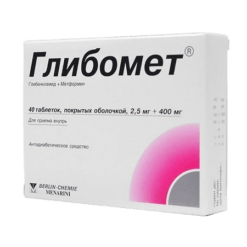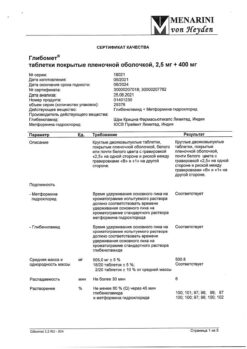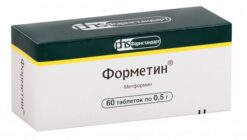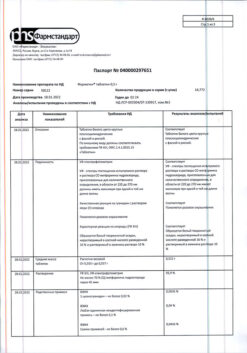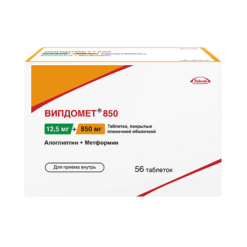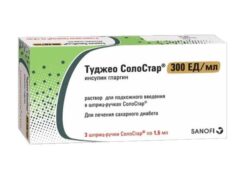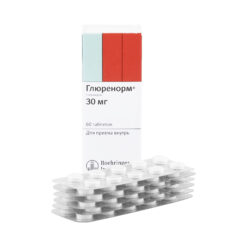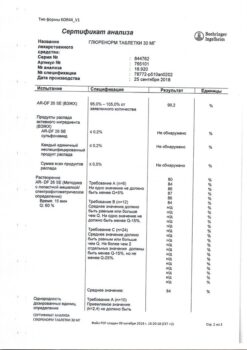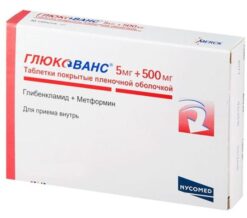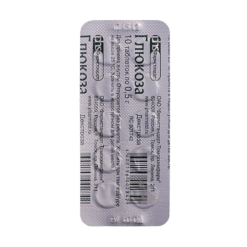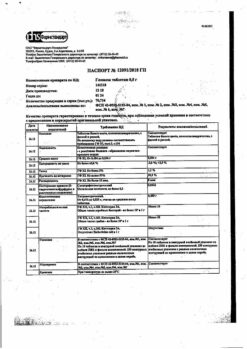No products in the cart.
Glimecomb, 40 mg+500 mg tablets 60 pcs
€1.00
Out of stock
(E-mail when Stock is available)
Description
Glimecomb is a combined hypoglycemic drug for oral administration. Glimecomb® is a fixed combination of two oral hypoglycemic agents of the group of biguanides and the group of sulfonylurea derivatives.
It has pancreatic and extrapancreatic action.
Glicliquid is a sulfonylurea derivative. It stimulates insulin secretion by the pancreas and increases the sensitivity of peripheral tissues to insulin. Stimulates the activity of intracellular enzymes – muscle glycogen synthetase. Restores the early peak of insulin secretion, shortens the period from the moment of food intake to the beginning of insulin secretion, and reduces postprandial hyperglycemia.
. In addition to influence on carbohydrate metabolism, it influences the microcirculation, reduces adhesion and aggregation of platelets, delays the development of mural thrombosis, normalizes vascular permeability and prevents the development of microthrombosis and atherosclerosis, restores the process of physiological mural fibrinolysis, counteracts the increased response to adrenaline of vessels in microangiopathies.
Inhibits the development of diabetic retinopathy at the nonproliferative stage; in diabetic nephropathy during long-term use it is registered a significant reduction of proteinuria. It does not lead to weight gain, as it mainly influences the early peak of insulin secretion and does not cause hyperinsulinemia; it promotes weight loss in obese patients by following the proper diet.
Metformin belongs to the group of biguanides. Reduces blood glucose concentration by inhibiting gluconeogenesis in the liver, reducing absorption of glucose from the gastrointestinal tract and increasing its utilization in tissues. Reduces serum concentrations of triglycerides, cholesterol and LDL (determined on an empty stomach) and does not change the concentration of other density lipoproteins. Helps to stabilize or reduce body weight. There is no therapeutic effect in the absence of insulin in the blood. Does not cause hypoglycemic reactions. Improves blood fibrinolytic properties due to the inhibition of tissue-type inhibitor of profibrinolysin activator (plasminogen).
Pharmacokinetics
Glyclazid
Intake and distribution
After oral administration, absorption is high. With a dose of 40 mg, Cmax in plasma is reached after 2-3 hours and is 2-3 µg/ml. Binding to plasma proteins is 85-97%.
Metabolism and excretion
Metabolized in the liver. T1/2 is 8-20 hours. It is excreted mainly as metabolites by kidneys – 70%, through the intestines – 12%.
In elderly patients no clinically significant changes of pharmacokinetic parameters were observed.
Metformin
Absorption and distribution
After oral administration absorption is 48-52%. It is rapidly absorbed from the gastrointestinal tract. Absolute bioavailability (fasting) is 50-60%. Cmax in plasma is reached after 1.81-2.69 hours and does not exceed 1 µg/ml. Dietary intake decreases Cmax in plasma by 40% and delays its achievement by 35 min. Binding to plasma proteins is insignificant. Metformin is able to accumulate in erythrocytes.
T1/2 is 6.2 h. It is excreted by kidneys, mainly unchanged (glomerular filtration and tubular secretion) and through intestine (up to 30%).
Indications
Indications
Type 2 diabetes mellitus with ineffective diet therapy, exercise and previous therapy with metformin or gliclazide.
Replacement of previous therapy with two drugs (metformin and gliclazide) in patients with type 2 diabetes mellitus with stable and well-controlled blood glucose levels.
Pharmacological effect
Pharmacological effect
Glimecomb is a combined hypoglycemic drug for oral use. Glimecomb® is a fixed combination of two oral hypoglycemic agents of the biguanide group and the group of sulfonylurea derivatives.
It has pancreatic and extrapancreatic effects.
Gliclazide is a sulfonylurea derivative. Stimulates the secretion of insulin by the pancreas, increases the sensitivity of peripheral tissues to insulin. Stimulates the activity of intracellular enzymes – muscle glycogen synthetase. Restores the early peak of insulin secretion, shortens the time interval from the moment of food intake to the onset of insulin secretion, and reduces postprandial hyperglycemia.
In addition to influencing carbohydrate metabolism, it has an effect on microcirculation, reduces platelet adhesion and aggregation, delays the development of parietal thrombosis, normalizes vascular permeability and prevents the development of microthrombosis and atherosclerosis, restores the process of physiological parietal fibrinolysis, and counteracts the increased response to vascular adrenaline in microangiopathies.
Slows down the development of diabetic retinopathy at the non-proliferative stage; in diabetic nephropathy, with long-term use, a significant decrease in proteinuria is observed. Does not lead to weight gain, because has a predominant effect on the early peak of insulin secretion and does not cause hyperinsulinemia; helps reduce body weight in obese patients when following an appropriate diet.
Metformin belongs to the group of biguanides. Reduces the concentration of glucose in the blood by inhibiting gluconeogenesis in the liver, reducing the absorption of glucose from the gastrointestinal tract and increasing its utilization in tissues. Reduces serum concentrations of triglycerides, cholesterol and LDL (determined on an empty stomach) and does not change the concentration of lipoproteins of other densities. Helps stabilize or reduce body weight. In the absence of insulin in the blood, the therapeutic effect does not appear. Does not cause hypoglycemic reactions. Improves the fibrinolytic properties of blood by suppressing tissue-type profibrinolysin activator inhibitor (plasminogen).
Pharmacokinetics
Gliclazide
Suction and distribution
After oral administration, absorption is high. When taken at a dose of 40 mg, Cmax in blood plasma is achieved after 2-3 hours and is 2-3 mcg/ml. Plasma protein binding is 85-97%.
Metabolism and excretion
Metabolized in the liver. T1/2 – 8-20 hours. Excreted mainly in the form of metabolites by the kidneys – 70%, through the intestines – 12%.
In elderly patients, clinically significant changes in pharmacokinetic parameters are not observed.
Metformin
Suction and distribution
After oral administration, absorption is 48-52%. Rapidly absorbed from the gastrointestinal tract. Absolute bioavailability (on an empty stomach) is 50-60%. Cmax in blood plasma is achieved after 1.81-2.69 hours and does not exceed 1 mcg/ml. Taking with food reduces Cmax in plasma by 40% and slows its achievement by 35 minutes. Plasma protein binding is negligible. Metformin can accumulate in red blood cells.
Removal
T1/2 is 6.2 hours. It is excreted by the kidneys, mainly unchanged (glomerular filtration and tubular secretion) and through the intestines (up to 30%).
Active ingredient
Active ingredient
Gliclazide, Metformin
Composition
Composition
One tablet contains:
active substances:
Contraindications
Contraindications
diabetes mellitus type 1 (insulin dependent);
diabetic ketoacidosis;
diabetic precoma, diabetic coma;
hypoglycemia;
severe renal dysfunction;
acute conditions that can lead to changes in kidney function: dehydration, severe infection, shock;
acute or chronic diseases accompanied by tissue hypoxia: heart failure, respiratory failure, recent myocardial infarction, shock;
liver failure;
porphyria;
pregnancy;
lactation period (breastfeeding);
simultaneous use of miconazole;
conditions requiring insulin therapy, incl. infectious diseases, major surgical interventions, injuries, extensive burns;
chronic alcoholism;
acute alcohol intoxication;
lactic acidosis (including history);
use for at least 48 hours before and 48 hours after radioisotope or x-ray studies with the introduction of an iodine-containing contrast agent;
following a hypocaloric diet (less than 1000 cal/day);
hypersensitivity to the components of the drug;
hypersensitivity to other sulfonylurea derivatives.
It is not recommended to use the drug in patients over 60 years of age who perform heavy physical work, which is associated with an increased risk of developing lactic acidosis.
The drug should be used with caution in case of febrile syndrome, adrenal insufficiency, hypofunction of the anterior pituitary gland, diseases of the thyroid gland with impaired function.
Side Effects
Side Effects
From the endocrine system: hypoglycemia (in case of violation of the dosage regimen and inadequate diet) – headache, feeling of fatigue, hunger, increased sweating, severe weakness, palpitations, dizziness, impaired coordination of movements, temporary neurological disorders; As hypoglycemia progresses, loss of self-control and loss of consciousness are possible.
Metabolism: in some cases – lactic acidosis (weakness, myalgia, respiratory disorders, drowsiness, abdominal pain, hypothermia, decreased blood pressure, bradyarrhythmia).
From the digestive system: dyspepsia (nausea, diarrhea, feeling of heaviness in the epigastrium, “metallic” taste in the mouth), decreased appetite (the severity of these reactions decreases when taking the drug with meals); rarely – hepatitis, cholestatic jaundice (drug discontinuation required), increased activity of liver transaminases, alkaline phosphatase.
From the hematopoietic system: rarely – inhibition of bone marrow hematopoiesis (anemia, thrombocytopenia, leukopenia).
Allergic reactions: itching, urticaria, maculopapular rash.
Other: visual impairment.
In cases of side effects, the dose should be reduced or the drug should be temporarily discontinued.
Common side effects of sulfonylureas: erythropenia, agranulocytosis, hemolytic anemia, pancytopenia, allergic vasculitis, life-threatening liver failure.
Interaction
Interaction
An increase in the hypoglycemic effect of the drug Glimecomb is observed when used simultaneously with ACE inhibitors (captopril, enalapril), histamine H2 receptor blockers (cimetidine), antifungal drugs (miconazole, fluconazole), NSAIDs (phenylbutazone, azapropazone, oxyphenbutazone), with fibrates (clofibrate, bezafibrate), anti-tuberculosis drugs (ethionamide), salicylates, coumarin anticoagulants, anabolic steroids, beta-blockers, MAO inhibitors, long-acting sulfonamides, with cyclophosphamide, chloramphenicol, fenfluramine, fluoxetine, guanethidine, pentoxifylline, tetracycline, theophylline, blockers of tubular secretion, reserpine, bromocriptine, disopyramide, pyridoxine, with other hypoglycemic drugs (including acarbose, biguanides, insulin), allopurinol, oxytetracycline.
A decrease in the hypoglycemic effect of the drug Glimecomb is observed when used simultaneously with barbiturates, corticosteroids, adrenomimetics (epinephrine, clonidine), antiepileptic drugs (phenytoin), with slow calcium channel blockers, carbonic anhydrase inhibitors (acetazolamide), thiazide diuretics, chlorthalidone, furosemide, triamterene, asparaginase, with baclofen, danazol, diazoxide, isoniazid, with morphine, ritodrine, salbutamol, terbutaline, with glucagon, rifampicin, with thyroid hormones, lithium salts, with high doses of nicotinic acid, chlorpromazine, oral contraceptives and estrogens.
Increases the risk of developing ventricular extrasystole against the background of cardiac glycosides.
Medicines that inhibit bone marrow hematopoiesis increase the risk of myelosuppression.
Ethanol increases the likelihood of developing lactic acidosis.
Pharmacokinetic interaction
Metformin reduces Cmax in blood plasma and T1/2 of furosemide by 31 and 42.3%, respectively.
Furosemide increases the Cmax of metformin by 22%.
Nifedipine increases absorption, increases Cmax in blood plasma, and slows down the excretion of metformin.
Cationic drugs (amiloride, digoxin, morphine, procainamide, quinidine, quinine, ranitidine, triamterene and vancomycin), secreted in the tubules, compete for tubular transport systems and, with long-term therapy, can increase the Cmax of metformin in the blood plasma by 60%.
Overdose
Overdose
Symptoms: possible lactic acidosis (since the drug contains metformin), hypoglycemia.
Treatment: if symptoms of lactic acidosis appear, you should stop taking the drug. Lactic acidosis is a medical emergency; treatment is carried out in a hospital. The most effective treatment method is hemodialysis.
For mild or moderate hypoglycemia, glucose (dextrose) or sugar solution is taken orally. In case of severe hypoglycemia (loss of consciousness), a 40% dextrose (glucose) solution or glucagon is administered intravenously, intramuscularly or subcutaneously. After regaining consciousness, the patient must be given food rich in carbohydrates to avoid re-development of hypoglycemia.
Storage conditions
Storage conditions
In a dry place, protected from light, at a temperature not exceeding 25 °C.
Shelf life
Shelf life
2 years
Manufacturer
Manufacturer
Akrikhin JSC, Russia
Additional information
| Shelf life | 2 years |
|---|---|
| Conditions of storage | In a dry, light-protected place at a temperature not exceeding 25 °C. |
| Manufacturer | Akrihin HFC JSC, Russia |
| Medication form | pills |
| Brand | Akrihin HFC JSC |
Related products
Buy Glimecomb, 40 mg+500 mg tablets 60 pcs with delivery to USA, UK, Europe and over 120 other countries.




